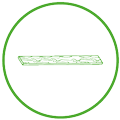The different products obtained are mostly exported overseas. High quality standards are followed full filling our most demanding customers needs.
Cycle of Pine

01.
Nurseries
Selected seeds are sown in beds to provide first quality seedlings.
02.
Soil Preparation
The soil is carefully prepared making furrows, and preserving its characteristics.
03.
Plantation
Once furrows are accomplished, manual plantation is carried out, controlling ants and other pests.
04.
Care
During the first years, seedlings are taken care of, with three types of treatment: herbicide to combat weeds, ant insecticide and plant fertilizer to provide the plants with adequate nutrition and obtain faster growth.
05.
Pruning
When trees are three years old, the first pruning is carried out, pursuing the obtention of knot-free timber of greater value. Pruning is performed up to a height of 6-7 m. Once the pruning process is completed, thinning begins. There are two different kinds: non-commercial and commercial.
06.
Final harvest
Finally, clear fell is performed arround the age of twenty three years old, and a new cycle begins.
07.
Logs
Final cut and thinning logs are carefully sorted according to different criteria to maximize yield.
08.
Sawmill
The sawmill handles logs in two different saw lines; one for thin logs and the other for large diameter logs. State of the art equipment warrants the maximum yield in first quality lumber.
09.
Driers
All sawmill output is carefully kiln dried. Customized drying schedules were developed specially for millwork applications.
10.
Energy
Waste from timber processing is conveyed to CHP facility to obtain electric energy and low pressure steam. The electric energy produced is sold mainly to the public utility company (UTE). 
11.
Millwork
KD lumber is graded or milled into high value products. These products are carefully packed in containers at the premises.

12.
Products
Most part of the volume manufactured is exported overseas. High quality standard procedures are followed to meet our customers’ needs.Pinus taeda properties
Name- Scientific name: Pinus taeda
- Common name: Loblolly Pine
- Argentina
- Brazil
- Native to Southeast USA
- Uruguay
- South Africa
Physical properties
General description
Pinus taeda´s timber is extraordinarily versatile. It is considered to be of average density, with fine texture, easy to dry and treat with preservatives. Excellent workability, nail fastening, resistance to splits and dimensional stability.- Janka Hardness: 28.9MPa.
- Nail removal: 715 (N/40 mm)
- Nail removal: 715 (N/40 mm)
- Nail removal: 715 (N/40 mm)
- Bulk density at 12 % moisture: 380-450 kg/m3.
- Dimensional stability: Volumetric shrinkage quotient 2
Timber description
- Sapwood: creamy- yellow.
- Heartwood: light brown.
- Fiber: straight except the heartwood.
- Characteristics: firm nodes, resiny, absence of stains.
- Sapwood: easily treatable for every use, even marine.
- Heartwood: treatable in compliance with standards of usage in contact with the soil, it does not appear in fast growth.
- Impregnability: good.
Utilizations
- Appearance (carpentry, furniture, molding, coating, covers, etc.).
- Structural (building and formwork).
- Packaging, pallets and fences.

